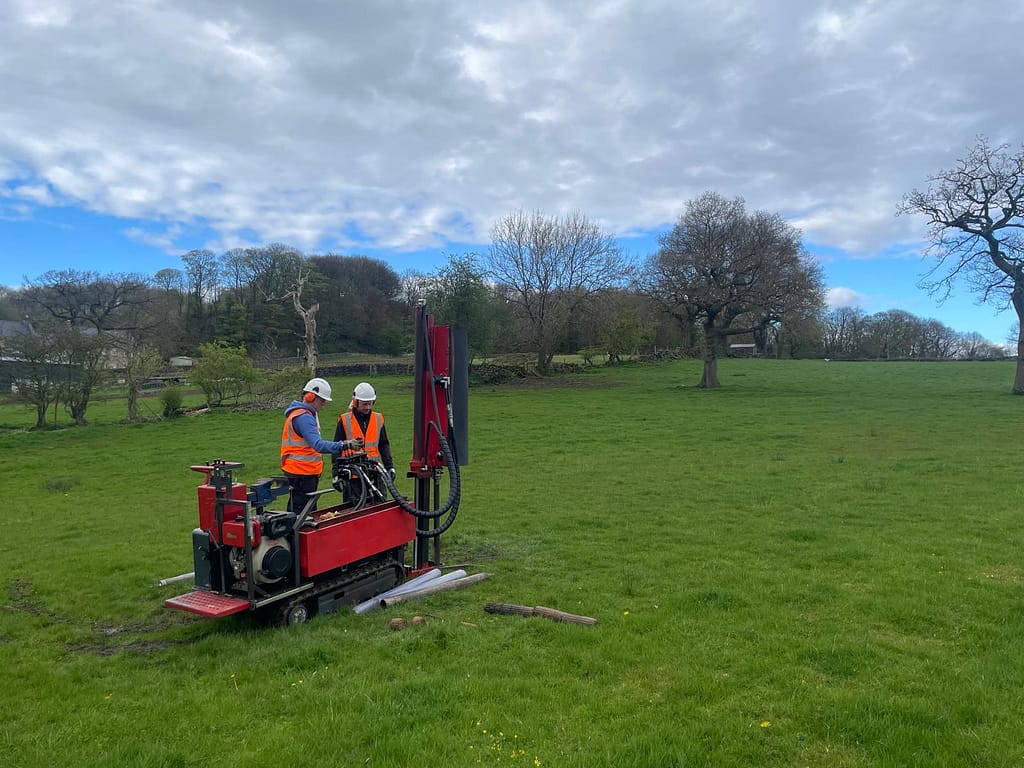
Our Services
We offer the following primary services:
- Windowless Sample Drilling (Using an Archway Dart Heavy Duty Rig) by NVQ L2 Certified Lead Drillers
- Installation of Groundwater / Gas Monitoring Wells
- Dynamic Probing and SPT Testing
- Concrete Coring (Rig Mounted Diamond Drilling)
- Foundation Inspection Pits
- Borehole Infiltration Testing (Falling Head)
- Soakaway Testing to BRE 365
- Sampling and Logging Services
- Provision of an Experienced Contracting Geologist for Consultancies at an Hourly Rate (assistance with reports, reviewing information, advice and production of detailed plans).
- Phase II Site Investigations and Associated Reporting
Please inquire if there is anything in addition to the above you require, we’re friendly, approachable and may be able to assist!
See below to learn more about our services!
Windowless Sampling
Windowless sample drilling is a quick and effective site investigation technique, which involves the drilling of exploratory boreholes to determine the ground conditions, obtain samples for laboratory testing, allow for in-situ strength / density testing and for the installation of ground gas and water monitoring wells. The drilling is undertaken using our Archway Dart Heavy Duty rig, a widely recognised and reliable piece of equipment, built here in the UK.
The percussive windowless sampling method involves driving steel auger tubes into the ground using the drilling rig, which achieves this using a hydraulically powered drop-weight, which hammers the tubes into the ground via an anvil. The drilling rig is mounted on rubber tracks, allowing it manoeuvre across greenfield sites and keeping ground surface disturbance minimal. In addition, the rig is well suited for areas with restricted access due to its width, which allows it to track through standard doorways, and its detachable drilling mast, which means boreholes can be drilled close to walls or in areas too tight for the rig itself to access.

The sample tubes are usually 1m long and contain a removable plastic liner. As they are driven into the ground, soil is forced into the sample tube. Steel rods are then used to drive the sample tubes to greater depths, retrieving each meter of sample via a hydraulic jacking system as the borehole progresses. Usually, standard penetration testing (SPT) is conducted between each sample retrieval, allowing a density / strength depth profile to be acquired during the advancement of the borehole. The maximum depth of a borehole which can be achieved will vary significantly with the ground conditions. Obstructions and very high density / strength soils will sometimes cause sampler or SPT refusal, in addition to rock quality strata (this method of drilling usually will not be advanced through rock). However, typical sampling depths tend to range from 2m to 5m, up to 10m where certain soil types are encountered, and the borehole remains open without support during drilling.
Due to the versatile nature of the drilling rig; concrete coring, breaking of hardstanding using a rig-powered hydraulic jackhammer and dynamic probing can all be carried out in addition to soil sampling.
Dynamic Probing
Dynamic probing is a continuous in-situ ground density and strength test, which involves percussively driving a steel cone into the ground using a windowless sample drilling rig. The number of blows is recorded for every 100mm of penetration, and these results can be correlated to standard penetration test ‘N’ values. The cone is attached to 1m steel rods and is generally sacrificed upon recovery of the rods. A torque reading of the rods at the end of each metre of penetration is obtained, which estimates the skin friction on the rods and this information can be used to adjust the data set to avoid exaggerated values with depth due to this affect. Rods are progressively added to the probing string, until the probe refuses to penetrate the ground, or the target depth of the test has been reached. The depth of testing achievable is primarily dependent on the density or strength of the material encountered; however, typical maximum test depths of between 5m and 10m can be anticipated.
The dynamic probe test provides a quick and relatively inexpensive method of assessing ground penetration resistance across a continuous depth profile, rather than at the discrete depths of a conventional SPT test.
Standard Penetration Testing
The standard penetration test, abbreviated as ‘SPT’, is an industry standard method, designed to obtain geotechnical engineering properties for foundation design. SPT testing is an in-situ testing method, carried out within and during the progression of a borehole. The results are generally converted to ‘N-values’, or ‘standard penetration resistance’, which are used to determine the in-situ density of granular soil or strength of cohesive soil.
Dependant on the nature of the soils encountered, the test involves either driving a 50mm barrel (‘spoon’) (cohesive soil) or a 60 degree cone (granular soil) into the ground through a depth of 450mm, with the number of blows counted for each 75mm increment. For cohesive soils, the sample obtained by the spoon is recovered after the test for visual examination and identification.
Soil Sampling and Logging
Peak Drilling offer soil sampling and logging services whilst on site with our drilling rig, carried out by an engineering geologist with over 10 years of experience. Soil logging is carried out to BS 5930 and can be issued the same day in electronic format. This service produces cost savings, by reducing the number of staff required on site. This service also enables consultancies to maximise the amount of site work they can accommodate, by freeing up their own engineers to supervise on other sites at the same time. With a substantial amount of experience working at a senior project management level within the industry, our site team fully understand the importance of good quality primary data, and will be there to offer guidance, allowing you to gain the most out of your site investigation.